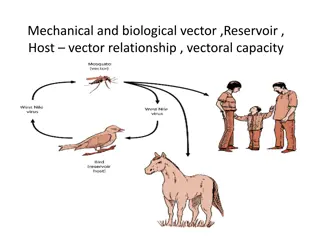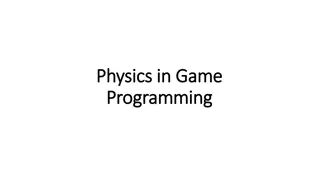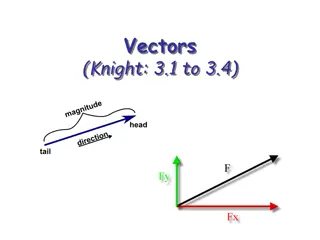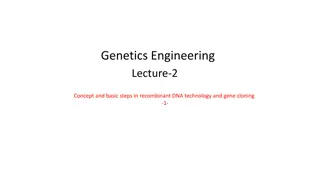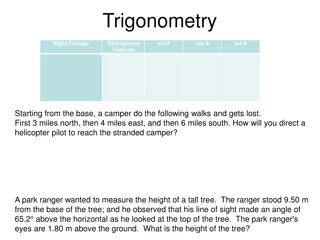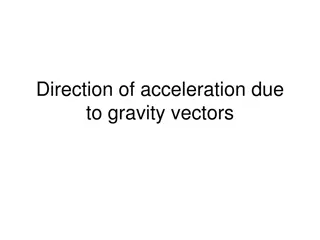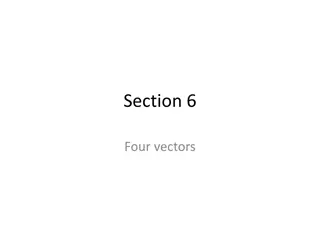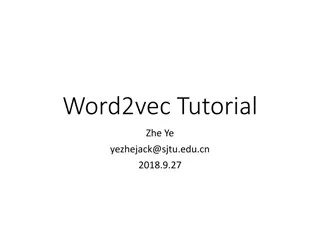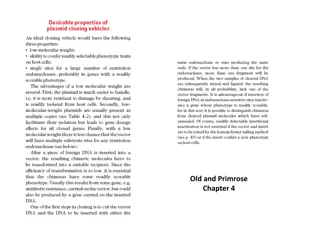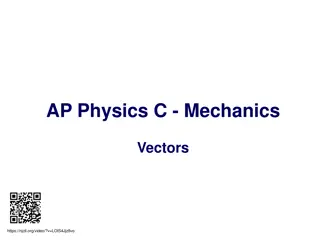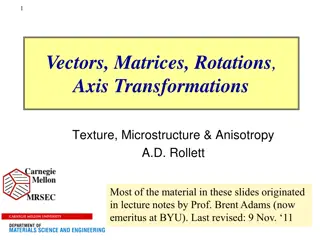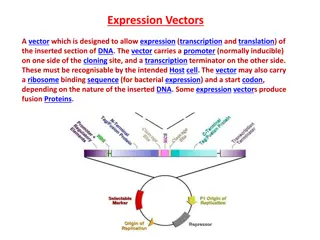
3D Cartesian Coordinates and Vector Calculations for Mathematics Enthusiasts
Dive into the world of 3D Cartesian coordinates and vector calculations with this detailed guide. Learn how to find distances, magnitudes, and unit vectors in three dimensions. Practice exercises included!
Download Presentation

Please find below an Image/Link to download the presentation.
The content on the website is provided AS IS for your information and personal use only. It may not be sold, licensed, or shared on other websites without obtaining consent from the author. If you encounter any issues during the download, it is possible that the publisher has removed the file from their server.
You are allowed to download the files provided on this website for personal or commercial use, subject to the condition that they are used lawfully. All files are the property of their respective owners.
The content on the website is provided AS IS for your information and personal use only. It may not be sold, licensed, or shared on other websites without obtaining consent from the author.
E N D
Presentation Transcript
Vectors Twitter: @Owen134866 www.mathsfreeresourcelibrary.com
Prior Knowledge Check 3) M is the midpoint of the line segment AB. 1) Given that ? = 3? ? and ? = ? + 2?, calculate: a) 2? + ? b) 3? + 4? Given that ?? = 4? + ?, 5? 13? + 11? a) Find ?? in terms of ? and ? 2? 1 2? 2) Given that ? = 5? 3?, work out: The point ? lies on ?? such that ??:?? = 3:1. 34 a) The magnitude of ? b) The unit vector that is parallel to ? b) Find ?? in terms of ? and ? 3? +3 5 34? 3 34? 4?
Teachings for Exercise 12A
Vectors You need to be able to use coordinates in 3 dimensions Cartesian coordinates in three dimensions are usually referred to as the x, y and z axes, each at right-angles to the other. Find the distance from the origin to the point P(4, 2, 5) z 5 Coordinates in 3 dimensions are given in the form (x, y, z) z 4 y 2 x Imagine the x and y-axes have fallen down flat, and the z-axis sticks up vertically out of the origin You can use the 3D version of Pythagoras Theorem The distance from the origin to the point (x, y, z) is given by: ?2+?2+?2 42+22+52 = y x = 6.71 (2dp) 12A
Vectors You need to be able to use coordinates in 3 dimensions Cartesian coordinates in three dimensions are usually referred to as the x, y and z axes, each at right-angles to the other. Find the distance between the points A(1, 3, 4) and B(8, 6, -5) First calculate the vector from A to B ?? = ? ? 8 6 1 3 4 = Coordinates in 3 dimensions are given in the form (x, y, z) z 5 7 3 9 = Then use 3D Pythagoras |??| = 72+ 32+ ( 9)2 = 139 = 11.8 (1dp) y x 12A
Vectors The coordinates of A and B are (5, 0, 3) and (4, 2, k) respectively. Given that |AB| is 3 units, find the possible values of k You need to be able to use coordinates in 3 dimensions Cartesian coordinates in three dimensions are usually referred to as the x, y and z axes, each at right-angles to the other. 4 2 ? 5 0 3 ?? = Calculate ?? using k 1 2 ? 3 ?? = Coordinates in 3 dimensions are given in the form (x, y, z) z Use Pythagoras in 3D Careful when squaring the bracket |AB| = 3 ( 1)2+22+ (? 3)2 ?? = ?2 6? + 14 ?? = ?2 6? + 14 3 = Square both sides 9 = ?2 6? + 14 Solve as a quadratic 0 = ?2 6? + 5 0 = (? 5)(? 1) y x ? = 5 ?? ? = 1 12A
Vectors You need to be able to use coordinates in 3 dimensions Please note that when operating in 3D, there can be some inconsistencies with which way the axes are labelled! Sometimes referred to as left handed or right handed! 12A
Vectors You need to be able to use coordinates in 3 dimensions Stick to this way! Please note that when operating in 3D, there can be some inconsistencies with which way the axes are labelled! 12A
Teachings for Exercise 12B
Vectors You need to be able to use vectors to describe movement in 3 dimensions 0 0 1 ? = You can use 3D vectors to describe movement in 3 dimensions A movement one unit in the z-direction z 1 0 0 ? = A movement one unit in the x-direction 0 1 0 ? = A movement one unit in the y-direction y x 12B
Vectors You need to be able to use vectors to describe movement in 3 dimensions You can use 3D vectors to describe movement in 3 dimensions z For any vector in 3 dimensions: ? ? ? ?? + ?? + ?? = y x 12B
Vectors You need to be able to use vectors to describe movement in 3 dimensions The position vector of a point is the vector to get to it from (0,0,0) Consider the points ?(1,5, 2) and ?(0, 3,7). ?? = ? + 5? 2? a) Find the position vectors of ? and ? in ??? notation. ?? = 3? + 7? b) Find the vector ?? as a column vector 12B
Vectors You need to be able to use vectors to describe movement in 3 dimensions ?? = ?? ?? Sub in the vectors we have as columns 0 1 5 Consider the points ?(1,5, 2) and ?(0, 3,7). ?? = 3 7 2 Calculate 1 8 9 ?? = a) Find the position vectors of ? and ? in ??? notation. ?? = 3? + 7? ?? = ? + 5? 2? b) Find the vector ?? as a column vector 12B
Vectors You need to be able to use vectors to describe movement in 3 dimensions 4? + ? Sub in ? and ? 2 4 = 4 + 3 5 2 0 Multiply the first by 4 The vectors ? and ? are given as: 8 4 = + 12 20 2 0 2 4 Add together and ? = . ? = 3 5 2 0 12 14 20 = a) Find: i) 4? + ? ii) 2? 3? b) State, with a reason, whether either of these vectors is parallel to 4? 5? 4? + ? = 14 20 12 12B
Vectors You need to be able to use vectors to describe movement in 3 dimensions 2? 3? Sub in ? and ? 2 4 = 2 3 3 5 2 0 Multiply the first by 2 and the second by 3 The vectors ? and ? are given as: 4 12 6 0 = 6 10 2 4 Add together and ? = . ? = 3 5 2 0 8 0 10 = a) Find: i) 4? + ? ii) 2? 3? b) State, with a reason, whether either of these vectors is parallel to 4? 5? 4? + ? = 14 20 12 8 0 10 2? 3? = 12B
Vectors To check if these are parallel to 4? 5?, take out a factor to make the ? terms equal 4 You need to be able to use vectors to describe movement in 3 dimensions Then compare if the vector becomes the same 4 0 as 4? 5? or 5 The vectors ? and ? are given as: 12 14 20 8 0 10 2 4 4? + ? = 2? 3? = and ? = . ? = 3 5 2 0 4 14 4 0 2? 3? = 2 4? + ? = 3 3 a) Find: 20 3 5 i) 4? + ? ii) 2? 3? b) State, with a reason, whether either of these vectors is parallel to 4? 5? 4? + ? = 14 20 So only this one is parallel to 4? 5? 12 8 0 10 2? 3? = 12B
Vectors Imagine we represent the vector ?? + ?? (in 2 dimensions) using a right angled triangle, and calculate its magnitude You need to be able to use vectors to describe movement in 3 dimensions ?2+ ?2 ? You also need to be able to calculate unit vectors ? The second triangle is a unit vector (meaning it has a magnitude of 1), but in the same direction as the original vector Divide all sides by ?2+ ?2 1 ? So to find a unit vector parallel to another vector, divide all terms by the original vector s magnitude ?2+ ?2 ? This process also works in 3D! ?2+ ?2 12B
Vectors You need to be able to use vectors to describe movement in 3 dimensions ? = 2? ? + 4? Divide by ? 1 ? = 2? ? + 4? 21 Find the magnitude of ? = 2? ? + 4?, and hence find ?, the unit vector in the direction of ?. This notation means the unit vector parallel to ? (2)2+( 1)2+(4)2 ? = Calculate and leave as a surd ? = 21 Now divide the original vector by the magnitude calculated 12B
Vectors z y You need to be able to use vectors to describe movement in 3 dimensions ? ? ?? Given the vector: ? ? = 2? ? + 4?, with magnitude 21, calculate the angle between the vector and the ?, ?, and ?axes x Consider the diagram to the right, with the exact vector ? drawn, starting from the origin ???? =??? ??? Sub in letters from the diagram ? ? ?????= We can make a right angled triangle, which is leaning into the 3D space Sub in values from the diagram 2 ?????= 21 The end of the vector is when we use the value of ? given, in this case 2 Inverse cos ??= 64.1 12B
Vectors z y You need to be able to use vectors to describe movement in 3 dimensions ? ? ?? Given the vector: ? ? = 2? ? + 4?, with magnitude 21, calculate the angle between the vector and the ?, ?, and ?axes x You can use a very similar process for the angles between the axes, with the values of ? and ? from the vector instead Consider the diagram to the right, with the exact vector ? drawn, starting from the origin ? ? ?????= We can make a right angled triangle, which is leaning into the 3D space Sub in values from the diagram 1 ?????= 21 The end of the vector is when we use the value of ? given, in this case 2 Inverse cos ??= 102.6 12B
Vectors z y You need to be able to use vectors to describe movement in 3 dimensions ? ? ?? Given the vector: ? ? = 2? ? + 4?, with magnitude 21, calculate the angle between the vector and the ?, ?, and ?axes x You can use a very similar process for the angles between the axes, with the values of ? and ? from the vector instead Consider the diagram to the right, with the exact vector ? drawn, starting from the origin ? ? ?????= We can make a right angled triangle, which is leaning into the 3D space Sub in values from the diagram 4 ?????= 21 The end of the vector is when we use the value of ? given, in this case 2 Inverse cos ??= 29.2 12B
Vectors You need to be able to use vectors to describe movement in 3 dimensions Find the vector AB ?? = ? ? 3 4 4 2 7 ?? = The points ? and ? have position vectors 4? + 2? + 7? and 3? + 4? ? relative to a fixed origin O. Find ?? and show that ??? is isosceles. 1 1 2 8 ?? = Now find the magnitude of AB ( 1)2+22+ ( 8)2 |??| = Sketch (not to scale) ? |??| = 69 4 2 7 1 2 8 42+ 22+ 72 |??| = Find the magnitude of OA and OB using their position vectors |??| = 69 69 69 32+ 42+ ( 1)2 |??| = ? |??| = 26 Isosceles as 2 vectors have equal magnitudes 3 4 ? 26 1 12B
Teachings for Exercise 12C
Vectors ?? = ?? ?? You need to be able to solve geometric problems involving vectors in 3 dimensions Sub in values 1 2 ?? = 7 3 5 8 Calculate 1 2 5 ?, ?, ? and ? are the points (2, 5, 8), (1, 7, 3), (0,15, 10) and (2,19, 20) respectively. ?? = Write in the form specified ?? = ? 2? + 5? a) Find ?? and ??, giving your answers in the form ?? + ?? + ?? ?? = ? 2? + 5? ?? = 2? 4? + 10? ?? = ?? ?? Sub in values 0 2 ?? = 15 10 19 20 Calculate 2 4 10 ?? = Write in the form specified ?? = 2? 4? + 10? 12C
Vectors You need to be able to solve geometric problems involving vectors in 3 dimensions ?? = 2? 4? + 10? Factorise right side ?? = 2( ? 2? + 5?) Replace ?? = 2?? ?, ?, ? and ? are the points (2, 5, 8), (1, 7, 3), (0,15, 10) and (2,19, 20) respectively. a) Find ?? and ??, giving your answers in the form ?? + ?? + ?? ?? = ? 2? + 5? ?? = 2? 4? + 10? b) Show that the lines ?? and ?? are parallel and that ?? = 2?? 12C
Vectors You need to be able to solve geometric problems involving vectors in 3 dimensions ?, ?, ? and ? are the points (2, 5, 8), (1, 7, 3), (0,15, 10) and (2,19, 20) respectively. Since we have 2 unequal parallel sides, the quadrilateral must be a trapezium a) Find ?? and ??, giving your answers in the form ?? + ?? + ?? ?? = ? 2? + 5? ?? = 2? 4? + 10? ? b) Show that the lines ?? and ?? are parallel and that ?? = 2?? ? ? c) Hence, describe the quadrilateral ???? ? 12C
Vectors The letters given will always be clockwise or anticlockwise around the shape You need to be able to solve geometric problems involving vectors in 3 dimensions 4, 9, 3 ? 7, 7, 7 ? 1 5 7 1 5 7 ?, ? and ? are the points 4, 9, 3 , 7, 7, 7 and (8, 2,0) respectively. Find the coordinates of a point ? such that ???? forms a parallelogram. ? (8, 2,0) ? If this is to be a parallelogram, the vector ?? must equal vector ?? It is strongly advised that you draw sketches to help visualize problems ?? = ?? ?? Sub in values 8 7 The sketches do not have to be accurate, but can help indicate to you what information you need and how to get it ?? = 7 7 2 0 1 5 7 Calculate ?? = 1 5 7 So both ?? and ?? are equal to 12C
Vectors The letters given will always be clockwise or anticlockwise around the shape You need to be able to solve geometric problems involving vectors in 3 dimensions 4, 9, 3 ? 7, 7, 7 ? 1 5 7 1 5 7 ?, ? and ? are the points 4, 9, 3 , 7, 7, 7 and (8, 2,0) respectively. Find the coordinates of a point ? such that ???? forms a parallelogram. ? (8, 2,0) ? It is strongly advised that you draw sketches to help visualize problems ? = ? + ?? Sub in values 4 1 5 7 ? = + 9 3 The sketches do not have to be accurate, but can help indicate to you what information you need and how to get it Calculate 5 ? = 4 4 So the point S is 5, 4,4 12C
Vectors 3? + ? + 2 ? + 120? = ?? ?? + 4???? You need to be able to solve geometric problems involving vectors in 3 dimensions If these are equal, then the coefficients of ? must be the same on both sides This is also true of the ? and ?terms Given that: 3? + ? + 2 ? + 120? = ?? ?? + 4???? 3? = ?? It therefore follows that Find the values of ?, ? and ?. 3 = ? A common method that can be used in solving vector problems is comparing coefficients ? + 2 ? = ?? It therefore follows that ? + 2 = ? We already know ? = 3 This is effective since the vectors are broken down into their component parts 5 = ? Multiply by -1 5 = ? ? = 5 ? = 3 12C
Vectors 3? + ? + 2 ? + 120? = ?? ?? + 4???? You need to be able to solve geometric problems involving vectors in 3 dimensions If these are equal, then the coefficients of ? must be the same on both sides This is also true of the ? and ?terms Given that: 3? + ? + 2 ? + 120? = ?? ?? + 4???? 120? = 4???? It therefore follows that Find the values of ?, ? and ?. 120 = 4??? We know the values of ? and ?now A common method that can be used in solving vector problems is comparing coefficients 120 = 4 3 5 ? Calculate right side 120 = 60? Divide by -60 This is effective since the vectors are broken down into their component parts 2 = ? ? = 5 ? = 3 12C
Vectors ? ? ?? = ? + ? + ? You need to be able to solve geometric problems involving vectors in 3 dimensions ? ? ?? = ? + ? + ? ? ? The diagram shows a cuboid whose vertices are ?, ?, ?, ?, ?, ?, ? and ?. Vectors ?, ? and ? are the position vectors of the vertices ?, ? and ? respectively. Prove that diagonals ?? and ?? bisect each other. ? ? ? ? ? ? The vector ?? will be the vector ??, but multiplied by a constant (we will use ?) Start by assuming there is a point of intersection between the diagonals, called ? Replace vector ?? with the expression above ?? = ??? ?? = ? ? + ? + ? Find two different ways to get there from O (so, find the vector ?? in two ways). ?? = ?? + ?? + ?? Expand the bracket ?? = ?? + ?? + ?? One method should involve diagonal ??, and the other should involve diagonal ?? 12C
Vectors ? ? ?? = ? + ? + ? You need to be able to solve geometric problems involving vectors in 3 dimensions ? ? ?? = ? + ? + ? ? ? The diagram shows a cuboid whose vertices are ?, ?, ?, ?, ?, ?, ? and ?. Vectors ?, ? and ? are the position vectors of the vertices ?, ? and ? respectively. Prove that diagonals ?? and ?? bisect each other. ? ? ? ? ? ? We can also get from O to H using ?? and a multiple of ?? (using a different letter for the constant, ?) Start by assuming there is a point of intersection between the diagonals, called ? Replace vectors ?? and ?? using the expressions above Expand bracket ?? = ?? + ??? ?? = ? + ? ? + ? + ? Find two different ways to get there from O (so, find the vector ?? in two ways). ?? = ?? + ?? + ?? ?? = ?? + 1 ? ? + ?? ?? = ? ?? + ?? + ?? Rewrite so ?, ? and ? terms are together One method should involve diagonal ??, and the other should involve diagonal ?? ?? = ?? + 1 ? ? + ?? 12C
Vectors ? ? ?? = ? + ? + ? You need to be able to solve geometric problems involving vectors in 3 dimensions ? ? ?? = ? + ? + ? ? ? The diagram shows a cuboid whose vertices are ?, ?, ?, ?, ?, ?, ? and ?. Vectors ?, ? and ? are the position vectors of the vertices ?, ? and ? respectively. Prove that diagonals ?? and ?? bisect each other. ? ? ? ? ? ? We can now set the two expressions for ?? equal to each other ?? = ?? + ?? + ?? ?? + ?? + ?? = ?? + 1 ? ? + ?? Set ? coefficients equal Set ? coefficients equal ?? = ?? + 1 ? ? + ?? ? = ? ? = 1 ? Replace ? using the first equation ? = 0.5 ? = 1 ? ? = 0.5 Add ? 2? = 1 Divide by 2 ? = 0.5 12C
Vectors ? ? ?? = ? + ? + ? You need to be able to solve geometric problems involving vectors in 3 dimensions ? ? ?? = ? + ? + ? ? ? The diagram shows a cuboid whose vertices are ?, ?, ?, ?, ?, ?, ? and ?. Vectors ?, ? and ? are the position vectors of the vertices ?, ? and ? respectively. Prove that diagonals ?? and ?? bisect each other. ? ? ? ? ? ? ?? = ?? + ?? + ?? Replace ? terms with 0.5 ?? = ?? + ?? + ?? ?? = 0.5? + 0.5? + 0.5? Factorise ?? = ?? + 1 ? ? + ?? ?? = 0.5(? + ? + ?) We can replace the bracket ?? = 0.5?? ? = 0.5 ? = 0.5 This shows that diagonal ??has been bisected 12C
Vectors ? ? ?? = ? + ? + ? You need to be able to solve geometric problems involving vectors in 3 dimensions ? ? ?? = ? + ? + ? ? ? The diagram shows a cuboid whose vertices are ?, ?, ?, ?, ?, ?, ? and ?. Vectors ?, ? and ? are the position vectors of the vertices ?, ? and ? respectively. Prove that diagonals ?? and ?? bisect each other. ? ? ? ? ? ? Originally, we said that: ?? = ?? + ?? + ?? ?? = ??? We can replace the ? ?? = ?? + 1 ? ? + ?? ?? = 0.5?? ? = 0.5 This shows that diagonal ??has also been bisected ? = 0.5 ?? = 0.5? + 0.5? + 0.5? 12C
Teachings for Exercise 12D
Vectors Replace the forces You can use 3D vectors to model problems in Mechanics ? = ??+ ??+ ?? ? = 2? ? + 2? + ? + 3? 3? + 4? 3? 2? A particle of mass 0.5kg is acted on by 3 forces: ? = 5? ? 3? ? Calculate ??= 2? ? + 2? ? ??= ? + 3? 3? ? ??= 4? 3? 2? ? ? = 5? ? 3? ? a) Find the resultant force, ?, that acts on the particle. 12D
Vectors ? = ?? Sub in the resultant force and the mass You can use 3D vectors to model problems in Mechanics 5? ? 3? = 0.5? Calculate the acceleration (the answer will be in terms of ?, ? and ?) 10? 2? 6? = ? A particle of mass 0.5kg is acted on by 3 forces: ??= 2? ? + 2? ? ??= ? + 3? 3? ? ??= 4? 3? 2? ? ? = 5? ? 3? ? a) Find the resultant force, ?, that acts on the particle. b) Find the acceleration of the particle ? = 10? 2? 6? ?? 2 12D
Vectors You can use 3D vectors to model problems in Mechanics (10)2+( 2)2+( 6)2 ? = Calculate 140 ?? 2 ? = A particle of mass 0.5kg is acted on by 3 forces: ??= 2? ? + 2? ? ??= ? + 3? 3? ? ??= 4? 3? 2? ? ? = 5? ? 3? ? a) Find the resultant force, ?, that acts on the particle. b) Find the acceleration of the particle ? = 10? 2? 6? ?? 2 c) Find the magnitude of the acceleration 12D
Vectors 140 ? = 6 ? = ? ? = ? = ? ? = 0 You can use 3D vectors to model problems in Mechanics ? = ?? +1 2??2 A particle of mass 0.5kg is acted on by 3 forces: Sub in values ? = (0)(6) +1 140(6)2 2 ??= 2? ? + 2? ? ??= ? + 3? 3? ? ??= 4? 3? 2? ? Calculate ? = 36 35 ? ? = 5? ? 3? ? ? = 10? 2? 6? ?? 2 140 ?? 2 ? = d) Given that the particle starts at rest, find the distance travelled in the first 6 seconds of its motion 12D






